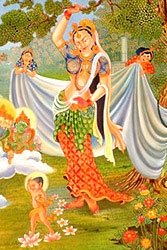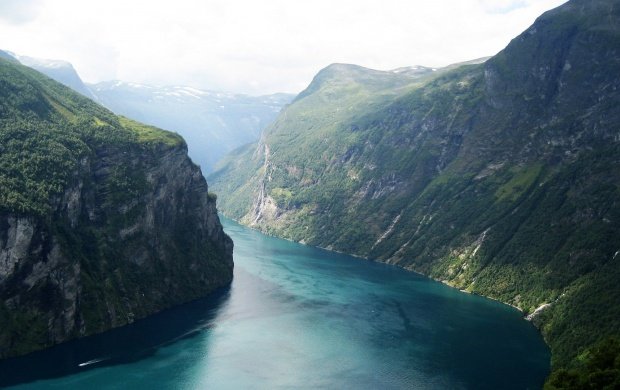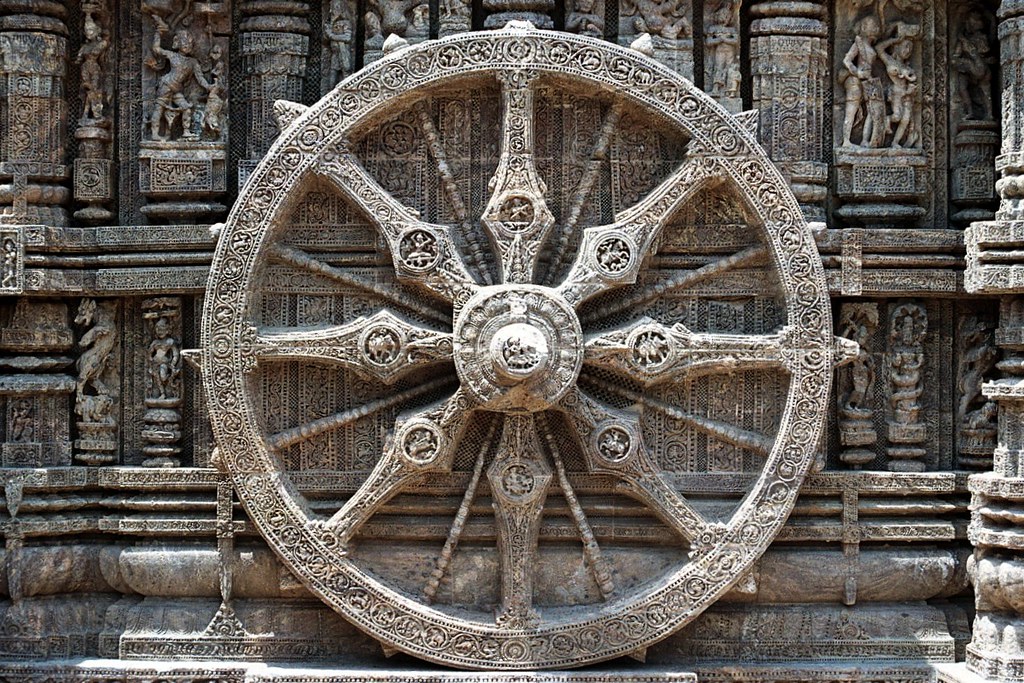In many Buddhist traditions, there are infinite buddhas in a world system characterized by cyclic time. Across infinite parallel variations, every universe is created, thrives, and dies, to be then be born again. Despite the plethora of buddhas, each singular universe only ever has one buddha born into it. Our current universe already received its buddha, the great Śakyamuni Buddha, known too as Siddhartha Gautama. (Tenzin Chögyel, 3-8) In the Buddha’s lifetime defined by his existence in a physical body born into this world, he performed 12 great acts. These are not the only spectacular deeds that he performed, but these 12 characterize chapters which together chronicle the Buddha’s life. From here, the Buddha will be referred to as the Bodhisattva until act ten, when he achieves full enlightenment.
1 – The descent from the Pure Land of Tushita:
The Bodhisattva’s story begins with his life before the one in our world, when he was born as a god in the paradise Tushita. He had already undergone numerous countless eons of lives, and had long ago taken his vow to become a buddha. The Bodhisattva determined, after teaching to the gods for many years, that he should be reborn again into our world in order to teach the truth during one of the darkest times. (Chögyel, 12) And so he chose Mayadevi, wife of the King of Suddhodana, to be his mother.
2 – Entering his mother’s womb:
The Bodhisattva entered the right side of his mother’s womb without causing her pain. She was saw him as a white baby elephant with six gold tusks. He lived within a three-story palace in her womb for ten to 12 months, and taught many guests, including Brahma. (Chögyel, 17) Some say that he could have been born miraculously, and, applying upaya, say that he chose to do so to show that even ordinary humans with regular births can achieve enlightenment. (Thrangu Rinpoche, 2)

3 – Birth:
Mayadevi went to her garden in Lumbini, and came before a fig tree. There she gave birth to the Bodhisattva with no pain. He entered this world fully clothed, and took seven steps in each of the cardinal directions, prompting miraculous occurrences each time. He was given the name “Siddhartha” in Sanskrit, which means, “the one that makes everything possible.” (Thrangu Rinpoche, 3)
4 – Becoming skilled in sports, the arts, and sciences:
The Bodhisattva attended school as a young Śakya prince, and quickly demonstrated his knowledge and skills in every subject. There is some disagreement whether if he learned everything very quickly, if he knew everything to begin with and demonstrated it immediately, and if he knew everything to begin with but pretended not to as to demonstrate to humanity the importance of an education, and show that he was like us. (Chögyel, 27-29; Thrangu Rinpoche, 4; FPMT, 3)
5 – Enjoying the company of his wife and consorts:
(Some titles, like that used by Khenchen Thrangu Rinpoche, focus on the Bodhisattva’s marriage avoid mention of the consorts.)
At this time, the Bodhisattva found a wife and had a harem, both of which he enjoyed. Some say the Bodhisattva did this in order to demonstrate that he was familiar with pleasure, and could still reject it. (Buddhist Himalaya VOL. I NO. II ) Others add that the Bodhisattva enjoyed a full harem in order to demonstrate that even the greatest pleasures (as they put it) are nothing in comparison to enlightenment. (Thrangu Rinpoche, 4)
6 – Fleeing the palace and renunciation:
The Bodhisattva, having enjoyed many of life’s pleasures, snuck out of the palace four times. By one account, each time he saw something that taught him of the world. (Thrangu Rinpoche, 4) By others, he was the embodiment of each of those visions, and simply took their guises in order to test his charioteer. He interacted with or became an embodiment of age, sickness, death, and finally a renunciate. He then decided to leave the palace for good to become a renunciate himself.

7 – Practicing austerity:
The Bodhisattva practiced austerity for six years without finding enlightenment as a person, or intentionally did not find enlightenment for six years on purpose. In both cases, the lesson became that living in an extreme, either in extreme asceticism or in extreme pleasures like he did at the palace, was wrong. Instead, he learned (or demonstrated) that enlightenment will be found by going in the middle, by taking the Middle Path.

8 – Proceeding to the Bodhi tree:
The Bodhisattva journeyed to Bodhgaya in Magadha, where many buddhas had gone to become enlightened, to become enlightened himself. He sat beneath the Bodhi tree that grew the day of his birth, and vowed not to rise until he was enlightened.
9 – Defeating Mara’s hosts:
The demon Mara then came to lead the Bodhisattva astray, and tried with various tricks and persuasions. (Thrangu Rinpoche, 7) When those did not work, he brought a demon army, but their weapons turned to flowers in the air and their resolve buckled as the Bodhisattva met them with unending compassion. During this battle, he touched the his right hand to the ground to call the goddess of the earth, Sthavara, to witness him. (Chögyel, 59)
10 – Becoming fully enlightenment:
After defeating Mara and his armies but before dawn, the Bodhisattva worked through many great truths until, in an instant, he understood everything and achieved perfect enlightenment. (Chögyel, 61)
11 – Turning the wheel of the Dharma:
It is said that Buddha turned the wheel of the Dharma in three ways, which means he taught in three different manners. The first way he taught was the Hinayana, or “the Deficient/Little Vehicle,” the second Mahayana, or “the Great/Exalted Vehicle,” and the third Vajrayana, also known as “the Thunderbolt Vehicle” or “the way of the diamond.” (Quintman, 2019, RELI242).

12 – Demonstrating a release from all suffering by passing away:
The Buddha, despite being able to live forever in this world, chose to pass away and teach that loss is inherent in everything. In passing away, he fully passes out of Samsara and suffering. (Buddhist Himalaya VOL. I NO. II)
External Links:
This site has a description of the 12 acts, but more importantly contains the panels depicting these acts in the Memorial Shrine at Land of Medicine Buddha, painted by Thubten Gelek and assistant Ngawang Kunkhen. Their work took more than a year.
For a history of the Buddha’s life and a series of nine thangkas portraying it, click here.
This site features different and more in-depth versions of Mara’s battle against the Bodhisattva and the Bodhisattva’s enlightenment. It also shows a great set of murals, carvings, reliefs, statues, and paintings of scenes related to the battle.
Further Readings:
Nāgārjuna. “In Praise of the Twelve Deeds of the Buddha.” Lotsawa House, www.lotsawahouse.org/indian-masters/nagarjuna/praise-twelve-deeds. [A beautiful poetic homage to the buddha by Nāgārjuna, praising the Buddha’s twelve acts.]
Lingpa, Jigme. “Praise of the Twelve Acts of the Buddha.” Lotsawa House, www.lotsawahouse.org/tibetan-masters/jigme-lingpa/praise-twelve-acts-buddha. [A similar set of poetic verses as the ones above, again praising the twelve acts. This reading offers line-by-line translations of the original language into either two other languages or into a phonetic version of the original and English. Without being able to read what I believe is Sanskrit, I am at a loss.]
Vidyābhūṣaṇa, Satiś Chandra Achārya. “Mahāyāna and Hīnayāna.” Journal of the Royal Asiatic Society of Great Britain and Ireland, 1900, pp. 29–42. JSTOR, www.jstor.org/stable/25208166. [A very detailed description on the differences between Hinayana and Mahayana, the first two teachings of the Buddha.]
Carman, Rose. The Middle Way: Book of Poetry on Buddhism and Living Well. SCRIBD, SCRIBD, www.scribd.com/document/141286260/The-Middle-Way-Book-of-Poetry-on-Buddhism-and-Living-Well. [Some more recently produced poetry on the Middle Way, to contrast the older poetry and show how current Buddhists interact with Buddhist practices.]
References:
Berzin, Alexander. “The Twelve Deeds of a Buddha.” Study Buddhism, Berzin Archives, 2019, studybuddhism.com/en/advanced-studies/lam-rim/refuge/the-twelve-deeds-of-a-buddha. [An short list of the twelve acts with an introduction on their importance in the mahayana traditions.]
Chögyel Tenzin, and Kurtis R. Schaeffer. The Life of the Buddha. Penguin Classics, 2015. [A translation of the work written by a chief abbot of Bhutan, Tenzin Chögyel, as an instructional piece for young monks on the life of the buddha.]
Rinpoche, Thrangu. “The Twelve Deeds of the Buddha.” The Very Venerable 9th Khenchen Thrangu Rinpoche, www.rinpoche.com. [A summary of each of the twelve acts by the 9th Khenchen Thrangu Rinpoche.]
Rinpoche, Thrangu. “Twelve Principal Deeds of Lord Buddha.” Twelve Principal Deeds of Lord Buddha, 1989, enlight.lib.ntu.edu.tw/FULLTEXT/JR-BH/bh117477.htm. As recorded in Buddhist Himalaya VOL. I NO. II. [A similar summary of the twelve acts, which includes less upaya than the one above.]
Your entry was well organized which made it easy to follow. I also thought that the pictures you chose were very effective and relevant. My favorite part about your entry was that you took the time to include different perspectives when there were disputes over certain parts of the Buddha’s life story. There were some elements that could use a little bit of elaboration, but there was a lot of information to cover so it’s not a big concern.
Amazing Content! If you need some details about about Podcasting than have a look here UQ4
Great!!! Thank you for sharing this details. If you need some information about Airport Transfer than have a look here FQ6
Hey, I enjoyed reading your posts! You have great ideas. Are you looking to get resources about Online Business or some new insights? If so, check out my website YQ9
I know a lot of folks whom I think would really enjoy your content that covers in depth. I just hope you wouldn’t mind if I share your blog to our community. Thanks, and feel free to surf my website YH6 for content about Thai-Massage.